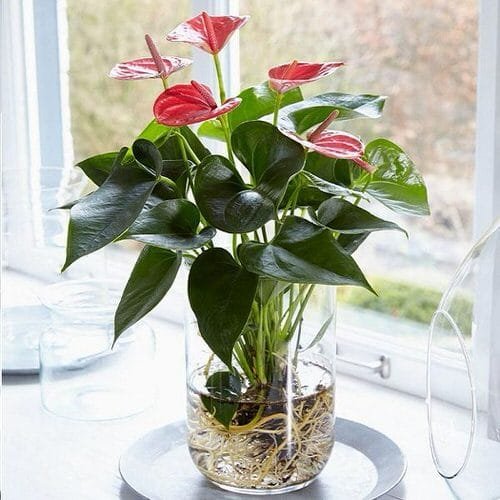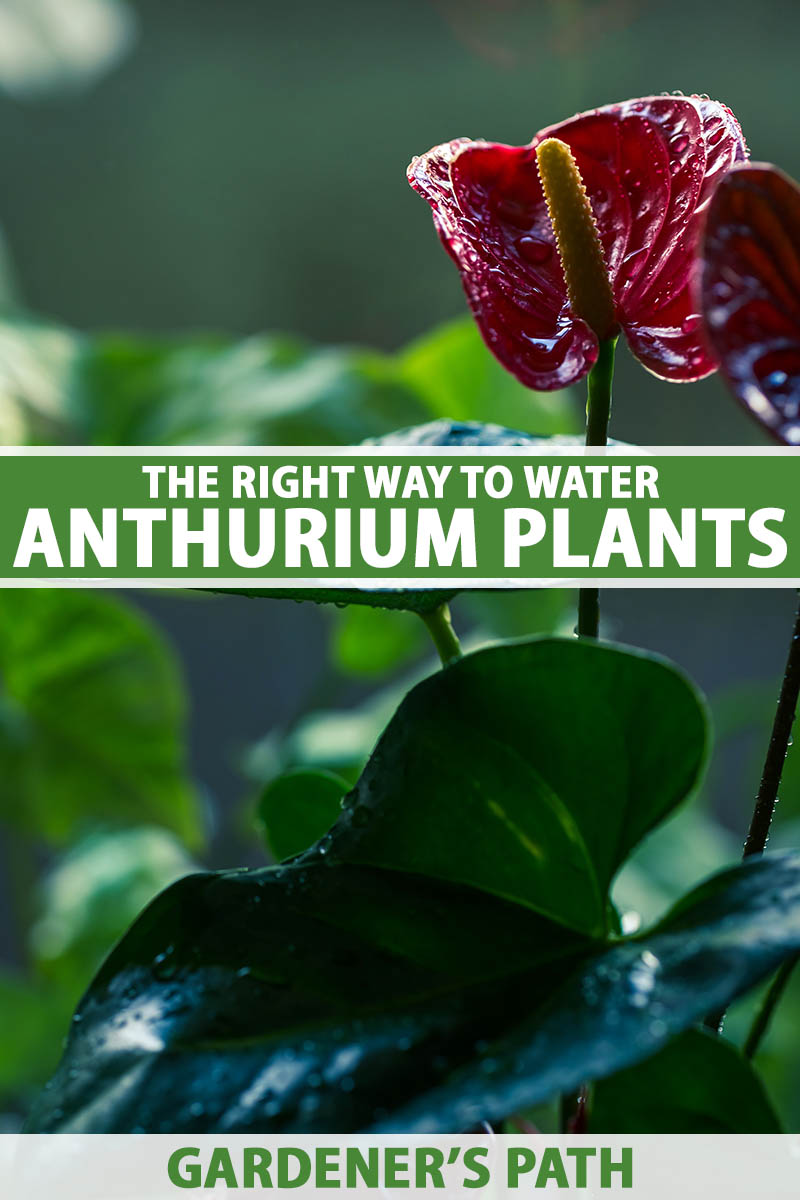To water anthurium, soak the soil thoroughly until excess water drains out and then allow the soil to dry out slightly before watering again. Anthuriums prefer to be kept slightly moist but not overly soggy.
Anthuriums, also known as flamingo flowers, are beautiful houseplants and add a touch of tropical elegance to any space. Proper watering is essential for their health and longevity. In this guide, we will explore the best practices for watering anthuriums to help you keep these stunning plants thriving.
Anthuriums are native to tropical rainforests, where they receive consistent rainfall. Therefore, when growing anthuriums as houseplants, it is important to replicate their natural environment as closely as possible. By providing the right amount of water, you can ensure that your anthurium stays happy and healthy. Let’s dive into the details of watering anthuriums the right way to help you achieve success with these stunning plants.

Credit: balconygardenweb.com
Importance Of Proper Watering
Proper watering is crucial for the health and growth of an anthurium plant. Overwatering and underwatering pose risks to the plant’s well-being. To maintain optimal soil moisture levels, it is essential to strike a balance between the two extremes. Excessive watering can lead to root rot and fungal diseases.
Conversely, underwatering can result in stunted growth and wilting. The impact of watering on anthurium growth cannot be overlooked. By providing the right amount of water, you can ensure the plant receives the necessary nutrients for vibrant blooms and lush foliage.
Regularly check the soil moisture to determine the watering needs of your anthurium. Remember, too little or too much water can adversely affect the plant’s overall health. So, water your anthurium carefully and watch it thrive.
How to Water Anthurium: Step by Step Guide
Understanding The Watering Needs Of Anthurium
Understanding the watering needs of anthurium is crucial for its overall health and growth. The frequency of watering anthurium depends on several factors. One of the key considerations is the type of soil and its moisture retention capabilities. Another factor is the size of the anthurium plant and its stage of growth.
Generally, anthuriums prefer a well-draining soil that is moist but not waterlogged. Overwatering can lead to root rot, while underwatering can cause the plant to wilt. It is important to choose the right watering method, such as using a watering can or misting the leaves, depending on the size and condition of the plant.
Factors such as temperature, humidity, and the amount of sunlight also influence the watering requirements of anthuriums. Monitoring the moisture levels and adjusting the frequency of watering accordingly will help maintain a healthy anthurium plant.
Best Practices For Watering Anthurium
Watering anthurium plants correctly is essential for their health and growth. When watering them indoors or outdoors, there are a few considerations to keep in mind. Firstly, choose the right container for your anthurium, ensuring it has proper drainage holes.
This will prevent water from accumulating and potentially causing root rot. Additionally, make sure to water your plant thoroughly but allow the soil to dry out slightly between waterings. Overwatering can lead to root damage, so it’s important to strike a balance.
To assist with drainage, you can add pebbles or broken pottery shards at the bottom of the container. This will help excess water to flow out of the pot. By following these best practices for watering anthurium, you can provide the ideal conditions for your plant’s overall health and longevity.
The Watering Process Step-By-Step
Watering anthurium plants requires a step-by-step approach. First, test the soil moisture to determine its hydration level. Measure the amount of water needed by assessing the dryness or dampness of the soil. Once determined, apply the water correctly to ensure proper hydration for the anthurium plant.
Following these guidelines will help maintain the plant’s health and vitality.
Signs Of Overwatering And Underwatering
Overwatering symptoms in an anthurium include yellowing leaves and root rot due to excessive moisture. Underwatering signs, on the other hand, manifest as drooping leaves and dry soil. Resolving watering issues requires adjusting the frequency and amount of water given to the plant.
Ensure that the soil is well-drained, and water only when the top inch of soil feels dry to the touch. Be careful not to overcompensate for underwatering by overwatering, as this can lead to more harm than good. Give the anthurium sufficient time to dry out between waterings, allowing the roots to breathe.
Proper watering techniques will help maintain a healthy anthurium and promote vibrant growth.
Additional Tips For Healthy Anthurium Watering
Watering your anthurium properly is crucial for its health. Using high-quality water is essential to avoid any contaminants that may harm the plant. Additionally, it is important to adjust the watering schedule according to different seasonal conditions. During hot summers, increase the frequency of watering, but be careful not to overwater.

In contrast, during winter, reduce watering to prevent the roots from rotting. Moreover, maintaining adequate humidity around the plant is crucial as anthuriums thrive in humid conditions. Mist the leaves regularly or place the pot on a tray filled with water and pebbles.
Following these tips will ensure that your anthurium remains healthy and vibrant throughout the year.
Frequently Asked Questions For How To Water Anthurium
How Often Should I Water My Anthurium?
Water your anthurium once every 7-10 days, allowing the top inch of soil to dry between waterings. Avoid overwatering, as it can lead to root rot. Ensure good drainage and use a well-draining soil mix to prevent waterlogging.
Can I Use Tap Water To Water My Anthurium?
Yes, you can use tap water to water your anthurium, but it may contain chlorine or other chemicals that can be harmful to the plant. It’s recommended to let tap water sit for 24 hours before using it to allow the chlorine to dissipate.
Alternatively, you can use filtered or distilled water.
How Do I Know If I Am Watering My Anthurium Correctly?
To ensure proper watering, insert your finger into the soil up to the first knuckle. If it feels slightly moist, then the plant doesn’t need water yet. If the soil feels dry, it’s time to water. Remember to adjust watering frequency based on the surrounding temperature and humidity levels.
Should I Mist My Anthurium?
While anthuriums appreciate a bit of humidity, misting the leaves is not enough to provide adequate moisture. Instead, place your anthurium on a tray filled with pebbles and water, ensuring the plant sits above the waterline. As the water evaporates, it will create a more humid environment around the plant.
What Should I Do If My Anthurium Leaves Turn Yellow?
Yellow leaves on an anthurium can indicate either overwatering or underwatering. Check the soil moisture level and adjust your watering accordingly. Ensure the plant is not receiving direct sunlight, as this can also cause leaf discoloration. If the problem persists, it may be a sign of a nutrition deficiency or pest infestation.
Conclusion
Properly watering your anthurium plant is crucial for its growth and overall health. By following a few simple guidelines, you can ensure that your plant receives the right amount of water it needs to thrive. Remember to water your anthurium thoroughly but avoid overwatering, as excessive moisture can lead to root rot and other problems.
It is important to let the top layer of soil dry out slightly between waterings, as this will prevent soggy conditions. Additionally, using distilled or filtered water can help prevent mineral buildup and keep your anthurium happy. Lastly, always pay attention to the specific needs of your plant, as individual factors such as light levels and temperature can affect its water requirements.
By understanding the unique needs of your anthurium and providing it with the proper care, you can enjoy a beautiful and flourishing plant for years to come.

